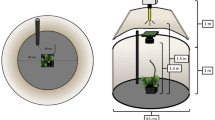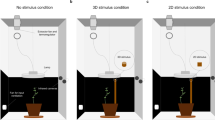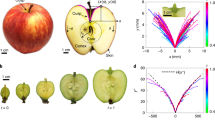Abstract
IN 1953, Arnal1 described a characteristic of nutation in Triticum coleoptiles which had been hitherto un-reported. His observation was that the movement of the coleoptile consisted of the propagation of a wave of bending, of more or less constant amplitude, from the tip of the growing zone towards the base of the organ. He noted that the increasing displacement of the tip from the mean position is caused by the increasing distance of the bend from the tip rather than by an increasing intensity of curvature of a fixed region of the organ. The organ was sometimes observed to possess two or more curvatures of opposite sense at different points along tho length of the growing zone.
This is a preview of subscription content, access via your institution
Access options
Subscribe to this journal
Receive 51 print issues and online access
$199.00 per year
only $3.90 per issue
Buy this article
- Purchase on Springer Link
- Instant access to full article PDF
Prices may be subject to local taxes which are calculated during checkout
Similar content being viewed by others
References
Arnal, C., Ann. Univ. sarav., Naturw. Sci., 2, 92 (1953).
Film directed by Calǎbec, J., available from Educational and Television Films Ltd., London.
Joerrens, G., Z. Bot., 49, 403 (1959).
Gradmann, H., Jb. Wiss. Bot., 65, 224 (1926).
Bennet-Clark, T. A., and Ball, N. G., J. Exp. Bot., 2, 169 (1951).
Author information
Authors and Affiliations
Rights and permissions
About this article
Cite this article
HEATHCOTE, D. Generation of Nutational Movements. Nature 208, 909–910 (1965). https://doi.org/10.1038/208909a0
Issue Date:
DOI: https://doi.org/10.1038/208909a0
This article is cited by
-
Circumnutation of Arabidopsis thaliana inflorescence stems
Biologia plantarum (2006)
Comments
By submitting a comment you agree to abide by our Terms and Community Guidelines. If you find something abusive or that does not comply with our terms or guidelines please flag it as inappropriate.



